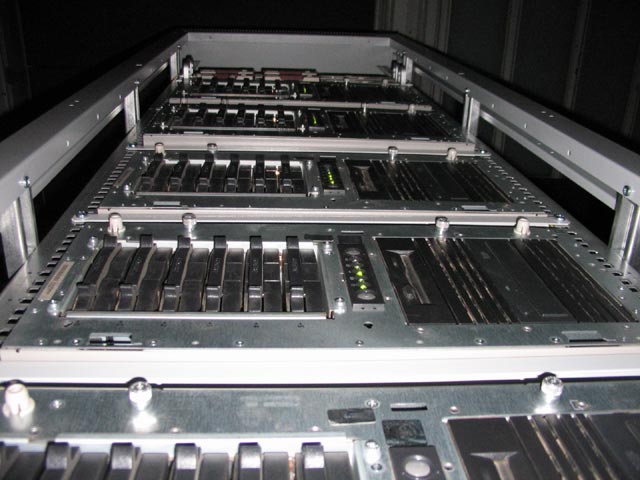
LASC is a Beowulf-like Linux cluster. It consists of 28 nodes: one front-end (master) node (SuperMicro FileServer), and 27 computational nodes (5 Compaq ProLiant ML350 G2, 2 SuperMicro SuperServer 6013A-T, 4 SuperMicro SuperServer 6014V-T2, 10 SuperMicro SuperServer 1020A-T servers) and 6 SuperMicro SuperServer 6015B-TV servers. The cluster is connected to the Internet through the Firewall. Each node has two Network Interface Cards (NICs), supporting the Fast (100 Mbps)/Gigabit (1000 Mbps) Ethernet connections.
The nodes are interconnected by two local area networks (LANs) operated through four 24-ports Gigabit Ethernet switches (Allied Telesyn AT-GS950/24). The first LAN is used for file exchange and communication purposes, whereas the second LAN is dedicated for data exchange during parallel computations.
The total resources available to the users are 110 CPUs, having the theoretical peak performance of about 218.9 GFLOPS (12.7 GFLOPS on 10 Pentium III-1.27 GHz + 18.36 GFLOPS on 6 Pentium IV XEON 3.06 GHz + 16.8 GFLOPS on 6 Pentium IV XEON 2.8 GHz + 64.0 GFLOPS on 16 Opteron Dual-core 270 2.0 GHz + 17.6 GFLOPS on 4 Opteron Dual-core 275 2.2 GHz + 89.3 GFLOPS on 6 Intel XEON 5320 Quad-core 1.86 GHz ), 220 GB RAM memory and 10.3 TB total hard disk space.

More details - http://tiger.cfi.lu.lv/lasc
A. KUZMIN, CLUSTER APPROACH TO HIGH PERFORMANCE COMPUTING. (Computer Modelling & New Technologies, 2003, 7 (2), p. 7-15), review about LASC cluster and it's possibilities. For internal server, we use 2 CPU Linux PC.
Moreover, we use servers abroad of partner groups in the framework of our collaboration with Max Planck Institute, Stuttgart (Germany), Osnabruck University (Germany), University of Western Ontario (Canada) and Uppsala University (Sweden)
Last Updated: October, 30, 2007


